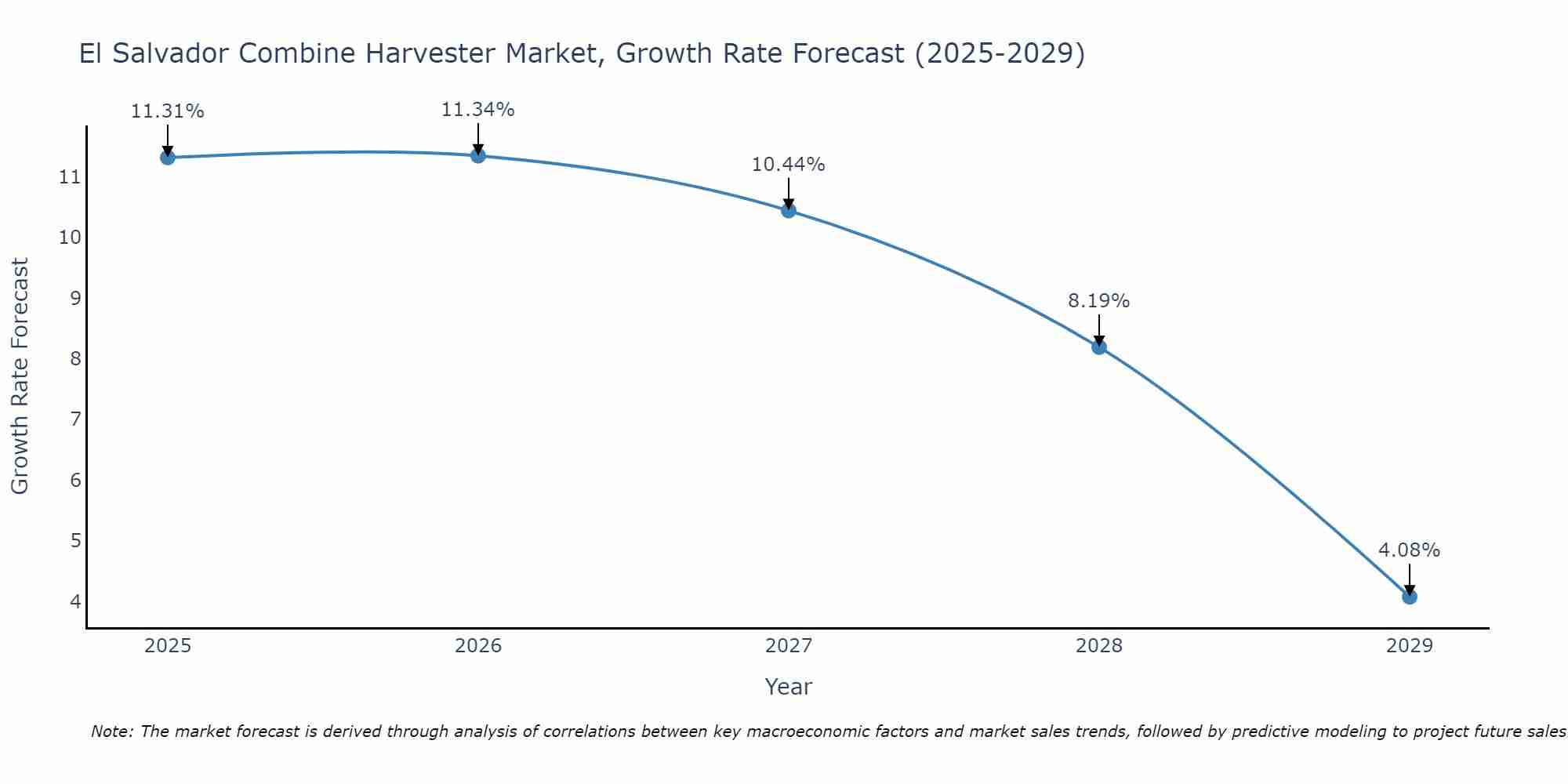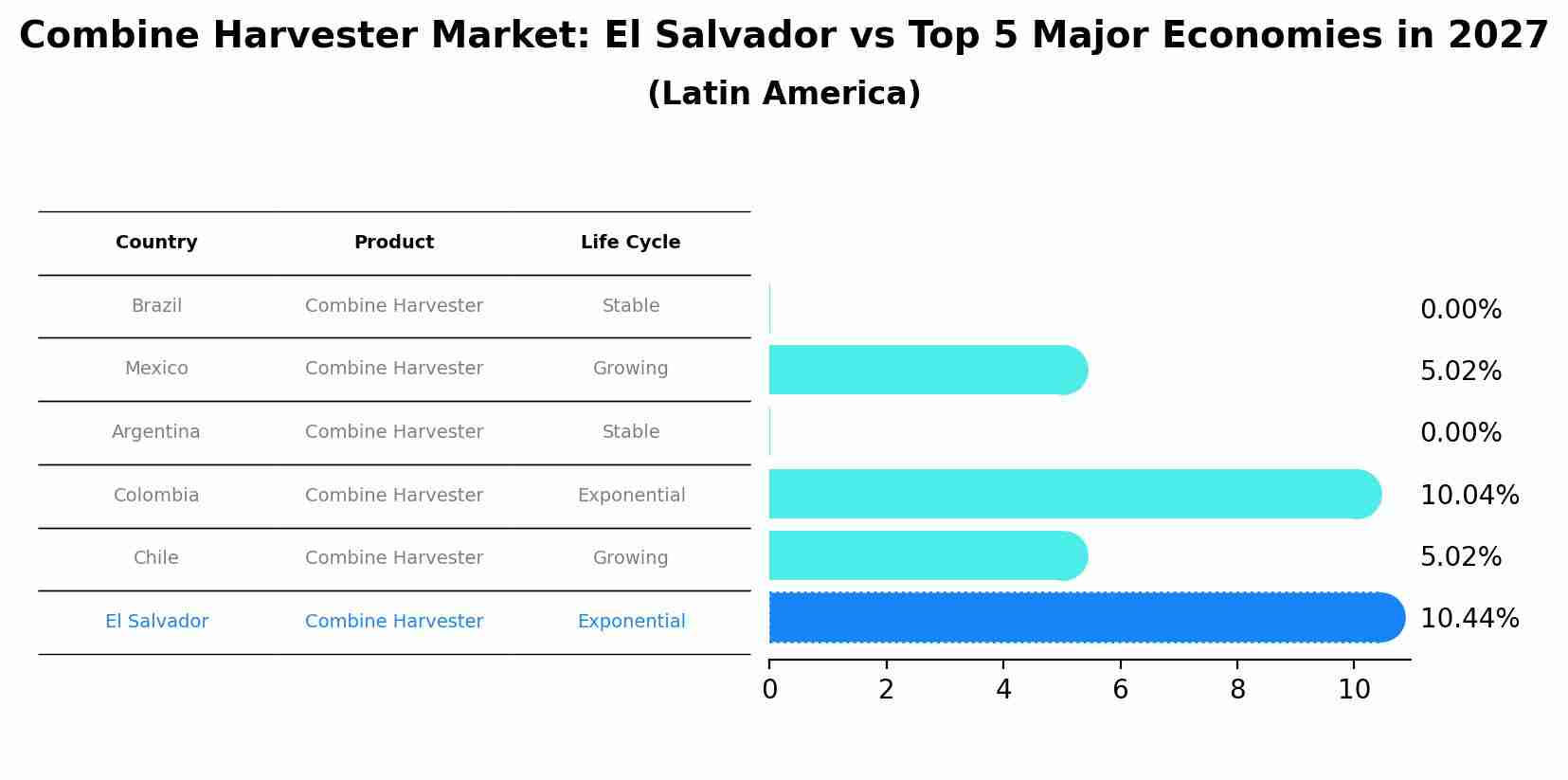El Salvador Combine Harvester Market (2025-2031) | Companies, Share, Outlook, Value, Segmentation, Trends, Industry, Revenue, Forecast, Analysis, Growth & Size
| Product Code: ETC5398233 | Publication Date: Nov 2023 | Updated Date: Oct 2025 | Product Type: Market Research Report | |
| Publisher: 6Wresearch | Author: Bhawna Singh | No. of Pages: 60 | No. of Figures: 30 | No. of Tables: 5 |
El Salvador Combine Harvester Market Size Growth Rate
The El Salvador Combine Harvester Market is projected to witness mixed growth rate patterns during 2025 to 2029. The growth rate begins at 11.31% in 2025, climbs to a high of 11.34% in 2026, and moderates to 4.08% by 2029.

Combine Harvester Market: El Salvador vs Top 5 Major Economies in 2027 (Latin America)
In the Latin America region, the Combine Harvester market in El Salvador is projected to expand at a high growth rate of 10.44% by 2027. The largest economy is Brazil, followed by Mexico, Argentina, Colombia and Chile.

El Salvador Combine Harvester Market Overview
The combine harvester market in El Salvador is growing, driven by the agricultural sectors increasing need for efficient and mechanized harvesting equipment. Combine harvesters are used to streamline the process of harvesting crops such as maize, beans, and other staple grains. As the agricultural industry becomes more mechanized to improve productivity and reduce labor costs, the demand for combine harvesters is expected to rise. Furthermore, the growing export opportunities for agricultural products in El Salvador will further drive market growth.
Drivers of the market
The combine harvester market in El Salvador is benefiting from the countrys agricultural sectors modernization efforts and the push toward greater efficiency in crop production. As the demand for staple crops such as corn, beans, and coffee rises, farmers are increasingly adopting mechanized harvesting solutions to reduce labor costs and increase productivity. The growing emphasis on agricultural sustainability and reducing post-harvest losses is also driving the adoption of advanced harvesting equipment like combine harvesters. Additionally, government incentives and agricultural development programs are encouraging the use of modern farming technologies in El Salvador.
Challenges of the market
The Combine Harvester Market in El Salvador faces challenges related to limited agricultural mechanization, financing difficulties, and reliance on imports. Although agriculture is a key sector in El Salvador, small and medium-sized farms, which dominate the landscape, often lack the capital to invest in expensive mechanized equipment such as combine harvesters. This reliance on manual labor for harvesting crops results in lower productivity and inefficient resource use. Moreover, access to financing and credit remains a challenge for many farmers, especially those in rural areas, which makes it harder to purchase high-cost equipment. Combine harvesters are often imported, and the high import duties and logistical costs associated with bringing such machinery into the country add to the burden on local farmers, limiting the growth potential of this market.
Government Policy of the market
The combine harvester market in El Salvador is hindered by the high initial cost of machinery, which is often unaffordable for small and medium-sized farmers. Limited access to financing options and a lack of maintenance services in rural areas also pose challenges to adoption. The seasonal nature of demand, tied to harvest cycles, further impacts the markets stability and growth potential.
Key Highlights of the Report:
- El Salvador Combine Harvester Market Outlook
- Market Size of El Salvador Combine Harvester Market, 2024
- Forecast of El Salvador Combine Harvester Market, 2031
- Historical Data and Forecast of El Salvador Combine Harvester Revenues & Volume for the Period 2021-2031
- El Salvador Combine Harvester Market Trend Evolution
- El Salvador Combine Harvester Market Drivers and Challenges
- El Salvador Combine Harvester Price Trends
- El Salvador Combine Harvester Porter`s Five Forces
- El Salvador Combine Harvester Industry Life Cycle
- Historical Data and Forecast of El Salvador Combine Harvester Market Revenues & Volume By Cutting Width for the Period 2021-2031
- Historical Data and Forecast of El Salvador Combine Harvester Market Revenues & Volume By Small Size Combine Harvester for the Period 2021-2031
- Historical Data and Forecast of El Salvador Combine Harvester Market Revenues & Volume By Large Size Combine Harvester for the Period 2021-2031
- Historical Data and Forecast of El Salvador Combine Harvester Market Revenues & Volume By Type for the Period 2021-2031
- Historical Data and Forecast of El Salvador Combine Harvester Market Revenues & Volume By Wheel Type Combine Harvester for the Period 2021-2031
- Historical Data and Forecast of El Salvador Combine Harvester Market Revenues & Volume By Crawler Type Combine Harvester for the Period 2021-2031
- Historical Data and Forecast of El Salvador Combine Harvester Market Revenues & Volume By Power Source for the Period 2021-2031
- Historical Data and Forecast of El Salvador Combine Harvester Market Revenues & Volume By Tractor Pulled/PTO Powered Combine Harvester for the Period 2021-2031
- Historical Data and Forecast of El Salvador Combine Harvester Market Revenues & Volume By Self-Propelled Combine Harvester for the Period 2021-2031
- El Salvador Combine Harvester Import Export Trade Statistics
- Market Opportunity Assessment By Cutting Width
- Market Opportunity Assessment By Type
- Market Opportunity Assessment By Power Source
- El Salvador Combine Harvester Top Companies Market Share
- El Salvador Combine Harvester Competitive Benchmarking By Technical and Operational Parameters
- El Salvador Combine Harvester Company Profiles
- El Salvador Combine Harvester Key Strategic Recommendations
Frequently Asked Questions About the Market Study (FAQs):
1 Executive Summary |
2 Introduction |
2.1 Key Highlights of the Report |
2.2 Report Description |
2.3 Market Scope & Segmentation |
2.4 Research Methodology |
2.5 Assumptions |
3 El Salvador Combine Harvester Market Overview |
3.1 El Salvador Country Macro Economic Indicators |
3.2 El Salvador Combine Harvester Market Revenues & Volume, 2021 & 2031F |
3.3 El Salvador Combine Harvester Market - Industry Life Cycle |
3.4 El Salvador Combine Harvester Market - Porter's Five Forces |
3.5 El Salvador Combine Harvester Market Revenues & Volume Share, By Cutting Width, 2021 & 2031F |
3.6 El Salvador Combine Harvester Market Revenues & Volume Share, By Type, 2021 & 2031F |
3.7 El Salvador Combine Harvester Market Revenues & Volume Share, By Power Source, 2021 & 2031F |
4 El Salvador Combine Harvester Market Dynamics |
4.1 Impact Analysis |
4.2 Market Drivers |
4.2.1 Increasing adoption of mechanized farming practices in El Salvador |
4.2.2 Government initiatives and subsidies to promote agricultural mechanization |
4.2.3 Growing demand for higher productivity and efficiency in agriculture |
4.3 Market Restraints |
4.3.1 High initial investment cost of combine harvesters |
4.3.2 Limited awareness and technical know-how among farmers |
4.3.3 Lack of infrastructure and maintenance support in rural areas |
5 El Salvador Combine Harvester Market Trends |
6 El Salvador Combine Harvester Market Segmentations |
6.1 El Salvador Combine Harvester Market, By Cutting Width |
6.1.1 Overview and Analysis |
6.1.2 El Salvador Combine Harvester Market Revenues & Volume, By Small Size Combine Harvester, 2021-2031F |
6.1.3 El Salvador Combine Harvester Market Revenues & Volume, By Large Size Combine Harvester, 2021-2031F |
6.2 El Salvador Combine Harvester Market, By Type |
6.2.1 Overview and Analysis |
6.2.2 El Salvador Combine Harvester Market Revenues & Volume, By Wheel Type Combine Harvester, 2021-2031F |
6.2.3 El Salvador Combine Harvester Market Revenues & Volume, By Crawler Type Combine Harvester, 2021-2031F |
6.3 El Salvador Combine Harvester Market, By Power Source |
6.3.1 Overview and Analysis |
6.3.2 El Salvador Combine Harvester Market Revenues & Volume, By Tractor Pulled/PTO Powered Combine Harvester, 2021-2031F |
6.3.3 El Salvador Combine Harvester Market Revenues & Volume, By Self-Propelled Combine Harvester, 2021-2031F |
7 El Salvador Combine Harvester Market Import-Export Trade Statistics |
7.1 El Salvador Combine Harvester Market Export to Major Countries |
7.2 El Salvador Combine Harvester Market Imports from Major Countries |
8 El Salvador Combine Harvester Market Key Performance Indicators |
8.1 Average age of combine harvesters in use |
8.2 Adoption rate of precision farming technologies |
8.3 Average yield per hectare of crops harvested with combine harvesters |
8.4 Percentage of farmers trained in operating and maintaining combine harvesters |
8.5 Utilization rate of combine harvesters during harvest seasons |
9 El Salvador Combine Harvester Market - Opportunity Assessment |
9.1 El Salvador Combine Harvester Market Opportunity Assessment, By Cutting Width, 2021 & 2031F |
9.2 El Salvador Combine Harvester Market Opportunity Assessment, By Type, 2021 & 2031F |
9.3 El Salvador Combine Harvester Market Opportunity Assessment, By Power Source, 2021 & 2031F |
10 El Salvador Combine Harvester Market - Competitive Landscape |
10.1 El Salvador Combine Harvester Market Revenue Share, By Companies, 2024 |
10.2 El Salvador Combine Harvester Market Competitive Benchmarking, By Operating and Technical Parameters |
11 Company Profiles |
12 Recommendations | 13 Disclaimer |
- Single User License$ 1,995
- Department License$ 2,400
- Site License$ 3,120
- Global License$ 3,795
Search
Thought Leadership and Analyst Meet
Our Clients
Related Reports
- Germany Breakfast Food Market (2026-2032) | Industry, Share, Growth, Size, Companies, Value, Analysis, Revenue, Trends, Forecast & Outlook
- Australia Briquette Market (2025-2031) | Growth, Size, Revenue, Forecast, Analysis, Trends, Value, Share, Industry & Companies
- Vietnam System Integrator Market (2025-2031) | Size, Companies, Analysis, Industry, Value, Forecast, Growth, Trends, Revenue & Share
- ASEAN and Thailand Brain Health Supplements Market (2025-2031) | Strategy, Consumer Insights, Analysis, Investment Trends, Opportunities, Growth, Size, Share, Industry, Revenue, Segments, Value, Segmentation, Supply, Forecast, Restraints, Outlook, Competition, Drivers, Trends, Demand, Pricing Analysis, Competitive, Strategic Insights, Companies, Challenges
- ASEAN Bearings Market (2025-2031) | Strategy, Consumer Insights, Analysis, Investment Trends, Opportunities, Growth, Size, Share, Industry, Revenue, Segments, Value, Segmentation, Supply, Forecast, Restraints, Outlook, Competition, Drivers, Trends, Demand, Pricing Analysis, Competitive, Strategic Insights, Companies, Challenges
- Europe Flooring Market (2025-2031) | Outlook, Share, Industry, Trends, Forecast, Companies, Revenue, Size, Analysis, Growth & Value
- Saudi Arabia Manlift Market (2025-2031) | Outlook, Size, Growth, Trends, Companies, Industry, Revenue, Value, Share, Forecast & Analysis
- Uganda Excavator, Crane, and Wheel Loaders Market (2025-2031) | Strategy, Consumer Insights, Analysis, Investment Trends, Opportunities, Growth, Size, Share, Industry, Revenue, Segments, Value, Segmentation, Supply, Forecast, Restraints, Outlook, Competition, Drivers, Trends, Demand, Pricing Analysis, Competitive, Strategic Insights, Companies, Challenges
- Rwanda Excavator, Crane, and Wheel Loaders Market (2025-2031) | Strategy, Consumer Insights, Analysis, Investment Trends, Opportunities, Growth, Size, Share, Industry, Revenue, Segments, Value, Segmentation, Supply, Forecast, Restraints, Outlook, Competition, Drivers, Trends, Demand, Pricing Analysis, Competitive, Strategic Insights, Companies, Challenges
- Kenya Excavator, Crane, and Wheel Loaders Market (2025-2031) | Strategy, Consumer Insights, Analysis, Investment Trends, Opportunities, Growth, Size, Share, Industry, Revenue, Segments, Value, Segmentation, Supply, Forecast, Restraints, Outlook, Competition, Drivers, Trends, Demand, Pricing Analysis, Competitive, Strategic Insights, Companies, Challenges
Industry Events and Analyst Meet
Whitepaper
- Middle East & Africa Commercial Security Market Click here to view more.
- Middle East & Africa Fire Safety Systems & Equipment Market Click here to view more.
- GCC Drone Market Click here to view more.
- Middle East Lighting Fixture Market Click here to view more.
- GCC Physical & Perimeter Security Market Click here to view more.
6WResearch In News
- Doha a strategic location for EV manufacturing hub: IPA Qatar
- Demand for luxury TVs surging in the GCC, says Samsung
- Empowering Growth: The Thriving Journey of Bangladesh’s Cable Industry
- Demand for luxury TVs surging in the GCC, says Samsung
- Video call with a traditional healer? Once unthinkable, it’s now common in South Africa
- Intelligent Buildings To Smooth GCC’s Path To Net Zero


















